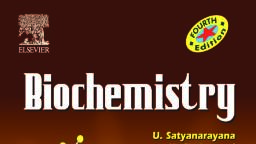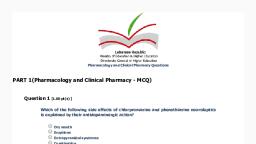Page 1 :
20. Metabolism of a drug primarily, results in:, , (a) Activation of the active drug, , (b) Conversion of prodrug to active, metabolite, , (c) Conversion of lipid soluble drugs to, water soluble metabolites, , (d) Conversion of water soluble drug to, lipid soluble metabolites, , 21. All of the following are advantages of, transdermal drug delivery systems, , EXCEPT:, , (a) They produce high peak plasma, concentration of the drug, , (b) They produce smooth and non, fluctuating plasma concentration of the, drug, , (c) They minimize inter individual, variations in the achieved plasma drug, concentration
Page 2 :
9:55PM -@ be eee, , , , (d) They avoid hepatic first pass, metabolism of the drug, , 22. Thiopentone is used for induction of, anaesthesia. It shows marked, , redistribution which is a characteristic of:, (a) Highly lipid soluble drugs, , (b) Highly water soluble drugs, , (c) Weak electrolytes, , (d) Highly plasma protein bound drugs, , 23. True statement about weakly basic, drugs is:, , (a) These are bound primarily to plasma, albumin, , (b) These are excreted faster in acidic, urine, , (c) Are highly ionized in the intestinal, juice, , (d) These are absorbed mainly from, stomach, , 24. Which of the following statements, about a drug having high plasma protein
Page 3 :
9:55PM -@ Pr eae i OB, , , , binding is true?, , (a) Volume of distribution of the drug is, very high, , (b) This drug will be filtered quickly by, glomerulus, , (c) This drug is likely to have minimum, chances of drug interactions, , (d) High plasma protein — binding, decreases the volume of distribution, , 25. Most common phase Il drug, metabolizing reaction is:, , (a) Glucuronidation, (b) Acetylation, (c) Oxidation, , (d) Glutathione conjugation, , 26. All of the following reactions are, catalyzed by microsomal enzymes, EXCEPT:, , (a) Glucuronidation, (b) Acetylation, (c) Oxidation
Page 4 :
9:55PM <4 cP eae | i i OB, , , , (d) Reduction, , 27. Which of the following factors has, maximum effect on filtration of a drug by, the, , glomerulus?, , (a) Lipid solubility, , (b) Plasma protein binding, (c) Degree of ionization, , (d) Rate of tubular secretion, , 28. A factor that is likely to increase the, duration of action of a drug D that is, , partially metabolized by CYP3A4 in the, liver is:, , (a) Chronic administration of, phenobarbital with the drug, , (b) Chronic administration of cimetidine, with the drug, , (c) Displacement from tissues binding, sites by another drug, , (d) Chronic administration of rifampicin, , 29. Drugs with high plasma_ protein





































































